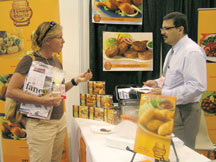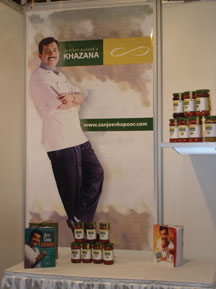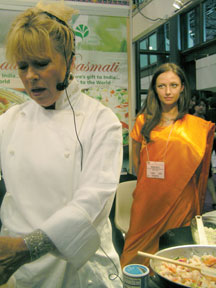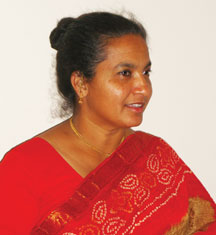Arts
A Touch of Spice

Are chili peppers taking over the world?
This year Pantone, the global authority on colors, selected Chili Pepper, a deep spicy red, as the color of the year, for everything from interior design to cell phones.
“In 2007, there is an awareness of the melding of diverse cultural influences, and Chili Pepper is a hreflection of exotic tastes both on the tongue and to the eye,” says Leatrice Eiseman, executive director of the Pantone Color Institute, adding that painting a wall in Chili Pepper will stir the appetite in a dining room, spark up a kitchen or add glamour and sensuality in a bedroom. What a sea-change for American palates that could not bear the heat and fire of spicy, flavorful foods. Now chili and spice are a part of the American diet and you see them making their way even into desserts and candy! All good news for Indian food, as it shifts from the margins into the mainstream. The new Packaged Facts report, The U.S. Market for Asian Foods, notes: “One of the fastest-growing and most diverse segments of the U.S. population, Asian Americans, are both driving the growth of Asian and Indian foods through their own spending power and, at the same time, changing the palates of their fellow Americans. A broad spectrum of food products from an increasingly wide range of Asian cuisines is fast finding a place in mainstream grocery channels and on mainstream American tables. Along with Chinese food, American consumers are embracing Japanese, Thai, Vietnamese, Indian, and other Asian cuisines, as well as Asian-inspired fusion dishes.”
Likewise, Specialty Food Magazine recently observed in an article on emerging food trends, “Mirroring the menus, cocktails are enticing consumers with Latin American, Asian and Indian flavors, too.” At long last, the future of desi khana seems assured in America now that Americans have finally got the Indian spice mix into their blood. Thanks to celebrity chefs, Indian restaurants, ready prepared foods and a number of cookbooks, Indian food has infiltrated the country.
India is also playing a part in food diplomacy, endearing its way into the international community’s heart through its stomach. It started this year with the export of Indian mangoes to the U.S. and continued with a heightened presence at the recent International Fancy Food and Confections Show organized by the National Association for the Specialty Food Trade (NASFT). The Indian pavilion, under the aegis of APEDA (Agricultural and Processed Food Products Export Development Authority) brought in basmati rice, processed foods and a whole kiosk of fresh mangoes, which were sliced up and fed to the thousands attending. A California chef demonstrated mango and basmati recipes to a receptive audience to generate mango-awareness. India produces over 50 percent of the total world production of mangoes and is vying to grab a major share of the export market. Recipes incorporating mangoes into just about everything from martinis to margaritas are being handed out at trade shows. Indian food products were also a part of the repertoire of companies from countries like Malaysia, Singapore, the Caribbean, South Africa and the UK. Some products are entirely Indian, while others have flavors or spices that Indian traders long ago brought to these countries. American manufacturers also seem to be cashing in on the new fad for Indian food and spices. Three years ago, Amy’s Kitchen in California introduced Indian heat-and-eat cuisine to mainstream audiences through major supermarkets and gourmet stores. Our samosas are finally going mainstream!
Dafur Pastry Kitchens of New York manufactures samosas as part of its hors d’oeuvres line, which includes Indian “salsa” curry Phyllo triangle – a salsa of toasted spices and tomatoes with paneer (homemade Indian cheese). It also sells curry pastry shells with Indian spices brightening the crispy cup. Kabobs Inc. in Lake City, Ga., offers several Indian products along with many other international ones. In poultry it has Chili Lime Chicken Kabob and Tandoori Chicken Satays. And yes, they offer chicken and vegetable samosas too. American companies are also sourcing their spices from India. Victoria Gourmet, a manufacturer and marketer of spice blends, has introduced new organic Tellicherry Peppercorns. “Black peppercorns are common, but a verified single source is uncommon,” says Victoria Taylor, who acquires the best Tellicherry Peppercorns from a trusted, small co-op farmers in India: “These come from Peermade, India, a plantation town south of the Idukki district with lush pepper vines and ideal growing conditions. They are certified organic.” This year Indian food at the specialty foods fair was very visible from three sources – local Indian American manufacturers, an entire pavilion of manufacturers from India, and manufacturers from the Diaspora. The Cremica Group Company founded by Rajni Bector, already established in Europe, UK, Australia and Middle East, was launched at the fair. It offers a range of Indian products, such as vegetarian mayonnaise, Indian flavored dips and syrups, ketchups, cookies and jams. In India, McDonalds, Pizza Hut, Domino’s, Papa John’s, and several airlines are using its products. Will these ubiquitous products catch on in America? Imagine Mrs. Bector as the next Mrs. Fields or Sara Lee!
The rising global aspirations can be seen in Clique Exports, a Mumbai based company headed by Manish and Amrita Majithia, which manufactures and exports West Indian, Jamaican, Caribbean and African food, such as Jamaican jerk seasoning, cassava flour, yam fufu and noodles from India. A number of Indian American companies have also jumped on to the Indian food train, manufacturing their own products both in the U.S. and India. All the major Indian American players, like Deep Foods, House of Spices, Raja Foods, Kohinoor and Maya Overseas Foods, are thriving and adding new products to their lines. The new buzzword seems to be “healthy” and Indian manufacturers are starting to capitalize on the trend. Deep Foods has introduced vegetarian masala burgers while Raja Foods is offering spicy veggie chicken nuggets and spicy burgers. Master chef Sanjeev Kapoor, celebrated TV host, restaurant consultant and author of best selling cookbooks, has branched out into processed food with his brand Sanjeev Kapoor’s Khazana, which has 123 Ready to Cook mixes for such dishes as Goan Fish Masala, Methi Chaman Biryani and Chikoo Walnut Kheer, blended masala, chutneys and sprinklers.The globalization of Indian cuisine is opening a new market for new products. A case in point is Narinder Jaisinghani of Veggie Delites and the Kebab Factory, which manufactures ready to eat, frozen vegetarian and non-vegetarian products. One of its exciting new products is Veggie Delites – just heat and eat, but with a difference. Now vegetarians can eat kebabs and chicken, which is so close to the original as to be almost scary! Veg Lolly, spicy vegetable mix on edible bread stick, and vegetable fingers, shami kebabs, paneer rolls, Hare Bhare Kebab and soya kebabs are some of the choices for vegetarians who generally are limited to deep fried samosas and pakoras. Indian food businesses are sprouting up all over the U.S. Taste of Malacca, headed by Susheela Raghavan, offers gourmet spice blends with four product lines. In San Ramon, Calif., the noted cookbook author Laxmi Hiremath has launched Laxmi Delights, which introduces her own creations, including organic Flaxseed Spread with Ginger and Honey, Date Spread with Orange Juice, and sweet, spiced nuts.
CAS Foods in Charlottesville, Va., offers several products, including Goa Coconut Curry and Madras Masala Curry. Another company Chanteclere Foods has launched a salad dressing, the Indian Curry Mango Dressing, a blend of exotic flavors, which can be used for marinating ingredients as well as dressings for salads. Cinnabar Specialty Foods, founded by Neera Tandon, in Prescott, Ariz., has several products, including Neera’s Urad and Channa Dal Mix and Neera’s Vegetable Chutney. Another company in Los Angeles, Calif., Commissariat Imports Inc., is distributing products under the Bombay Brand label and its Eggplant Pickle was a winner of the NASFT’s best aisle product. Award winning cookbook author Maya Kaimal has introduced a new line of chutneys recently while her line of simmer sauces, Tikka Masala, Coconut Curry, Tamarind Curry, Vindaloo and Classic Korma, hit the market in 2003. The products are hrefrigerated, all natural, vegetarian, preservative-free and made with high-quality ingredients, including fresh curry leaves, freshly ground spices and slowly caramelized onions “The market was already overcrowded with jarred sauces, but sauces were a great way to give people a shortcut to making Indian curries, so to differentiate our line we decided to make it hrefrigerated,” she says. “We were able to occupy a unique niche in the market and at the same time we were able to give Indian food a kind of gourmet cachet, because the part of the store we’d be shelved would it be near high end products like fine cheese, fresh pestos and pasta sauces. It gave us an opportunity to present Indian food as a more gourmet, high end, high quality product.” At the food show, she served the chutneys, which will be launched in October, in innovative ways – as dips, relishes, in salads and on crackers – targeting it as a crossover item. Curious crowds gathered to taste something new served in familiar ways. “Globalization is changing the face of India and Americans are seeing it as a glamorous, sophisticated place,” Kaimal says, which accounts for Indian food’s emerging star status. “There’s now a special appreciation of all things Indian. Indian food is finally being presented in a restaurant form that’s very elegant. This has been going on in the UK for a very long time, but finally in the U.S. you are getting people who are ready to spend a lot of money on a fine Indian meal.” She says that historically people thought of Indian food as inexpensive and couldn’t bring themselves to spend $20 on an entrée, but that’s changing and is hreflected in the rise of celebrity Indian chefs in America and Europe. Cuisine mirrors the fashion world: Designer labels inspire cheaper knock offs and the styles and innovations trickle down to the masses. In much the same way, packaged goods are reaching a larger market, because of the increased appeal of Indian food. “People are seeing many more Indians than they ever have in this country. Chances that people know Indians and have tasted their food, and chances of Americans traveling to India are high now,” says Kaimal. “The people that I know who really love Indian food and who are American, came to love it because an Indian person fed them, not because they ate it in an Indian restaurant or because they bought a bottle of Indian sauce or pickle.” Indian Americans in very personal and intimate ways are introducing Americans to the foods they have known since childhood. By eating a meal in someone’s house or sharing a co-worker’s packed lunch, Americans get to taste an authentic version of Indian food. A remarkable story of creating change at the grassroots is that of Rollo and Ann Varkey, two lone Indians in the small town of Pittsboro, N.C., which has only 3,000 residents. Most of them know about Indian cuisine, thanks to the Varkeys, who are creators of the Kerala Curry brand. “My wife Ann and I used to work for Nortel Networks at Research Triangle Park for over 16 years and started this food manufacturing business in 2002 when the telecommunication industry slowed down,” says Varkey, who is from Kerala. His small company is located in Pittsboro, in rural Chatham County, in a federally inspected USDA plant. “Under the Goodness Grows in North Carolina program, we try to buy most of our ingredients from North Carolina for our manufacturing needs, except spices, which come from Kerala,” he says. The couple use fresh North Carolina chicken in their products and raise Angus cattle on their 100-acre ranch. Starting with one product, a ready-to-eat chicken curry in a can five years ago, they now have 25 shelf stable products, bulk frozen curry products and fresh chilled individual meals in specialty and gourmet stores in over 22 states, including Hawaii. They are introducing a new line of frozen meals in sealed trays this year. Their products are sold at major stores like Whole Foods and a number of cooperatives, where most customers are mainstream Americans. All the products are manufactured in Pittsboro, except for the pappadams, which are imported from India. Yet even in this very rural Southern town, people are buying Kerala Curry. Varkey says all his neighbors love his wife’s chicken curry, and the ranchers wedge it between Southern biscuits and eat it as a sandwich. He says, “One of my neighbors does a lot of barbecue cooking and uses my meat masala on his pork and other meat cuts. Ranchers also use it for their venison meat, rural Southerners really love the curries!” And so, bite by bite and plate by plate, the spice revolution rolls on! |






